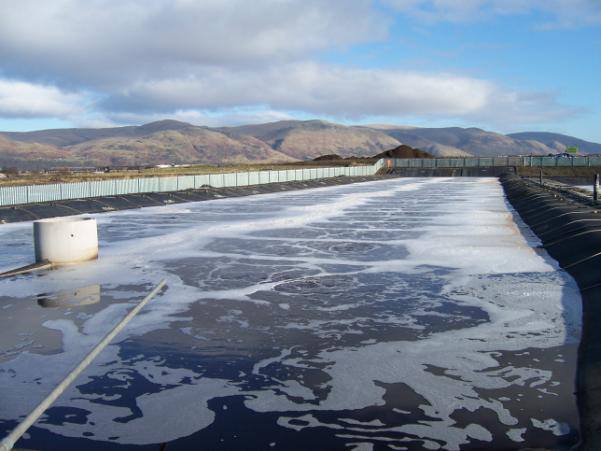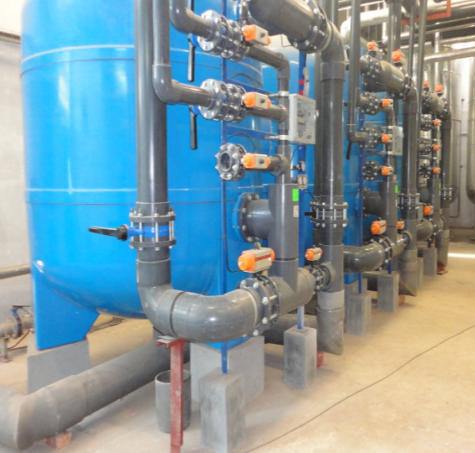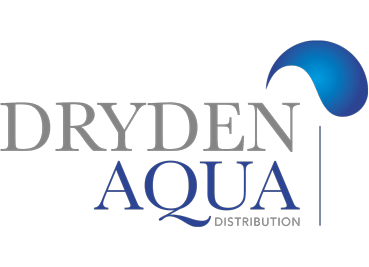Removal of arsenic, ferric and manganese
| Chemical parameter | Soluble fraction | Insoluble | Permitted concentration in drinking water | Typical performance at 5 - 10m/hr filtration velocity |
| Manganese | Mn2+ | Mn4+ | 50 ug/l | >80% |
| Ferric | Fe2+ | Fe3+ | 200 ug/l | >95% |
| Arsenic | As3+ | As5+ | 10ug/l | >90% |
Iron, manganese and arsenic are often found in borehole / tube wells and ground water at varying concentrations depending upon the geology of the ground. The technique used by Dryden Aqua to remove the chemicals is as follows:
Process
- Oxidation reactions to convert metals from soluble ionic form to insoluble oxidized precipitate, pH correction and redox correction
- Decantation may be required if the concentrations are above 5 mg/l, if not proceed to AFM® filtration
- AFM® filtration to remove the suspended metal oxide solids, there will also be adsorption reactions and surface oxidation reactions
Procedure
Oxidation:
This is achieved through aeration of the water. The water is aerated for a period of no less than 60 minutes. If water flow is 50 m3/h the aeration level is 100m3/h of air and tank volume is 50m3 of water. Dryden Aqua manufactures fine bubble drop-in air diffusers for this application.
pH:
The pH of the water should be increased to a value over pH 7.5
Redox:
The aeration system will increase the redox potential of the water. It is important to raise the potential to as high a value as possible. Certainly it should be over 200mv.
- Manganese oxidation requires a high oxidation potential, in some cases if there is a high BOD or organic content in the water it may be required to add additional oxidizing agent such as hypochlorite, chlorine dioxide, hydrogen peroxide or ozone. As an option to using an oxidizing agent ferric may be injected into the water to act as a catalysts to co-precipitate manganese. If this strategy is used, the amount of ferric equates with 2 x the molar quantity of manganese, e.g. for 0.1mg/l of manganese add 0.2 mg/l of ferric.
- Ferric oxidation is simple, the aeration system will more than suffice
- Arsenic oxidation also benefits from the addition of ferric to the water. Arsenic is removed by oxidation and co-precipitation with ferric, example 0.1 mg/l As requires up to 1 mg/l of ferric (as ferric chloride)
AFM® filtration
Pre-treatment of the water prior to filtration by AFM® is very important. AFM® will remove the metals and metalloid by the following mechanisms:
- Oxidation and adsorption (similar to greensands and ferric media)
- Adsorption of sub-micron metal oxide particles
- Physical filtration of most particles down to 1 micron

Operating parameters
AFM® filtration performance will depend upon the operating parameters. It is important to use good quality filters, we recommend filters in compliance to the German DIN standard. The following represent the optimum filter operating conditions.
| recommended | maximum | notes | |
|---|---|---|---|
| Bed depth AFM | 1200mm | 3000mm | Bulk bed density 1.25 to 1 |
| Run phase water flow | <5 m/hr | 10m/hr | The slower the flow rate the better the performance |
| Running pressures (differential) | <0.4 bar | <0.5bar | Do not exceed 0.5 bar differential |
| Back-wash water flow | >45m/hr | 60m/hr | Back-wash for 5 minutes, or until the water runs clear. Air purge not required. |
| Rinse phase duration | 5 minutes | ---- | It takes a few minutes for the bed to stabilize after a back-wash |
| Back-wash frequency / per week | 1 | 7 | Reduce back-washing to a minimum |

Webdesign by Bönzli + Feuz IT
